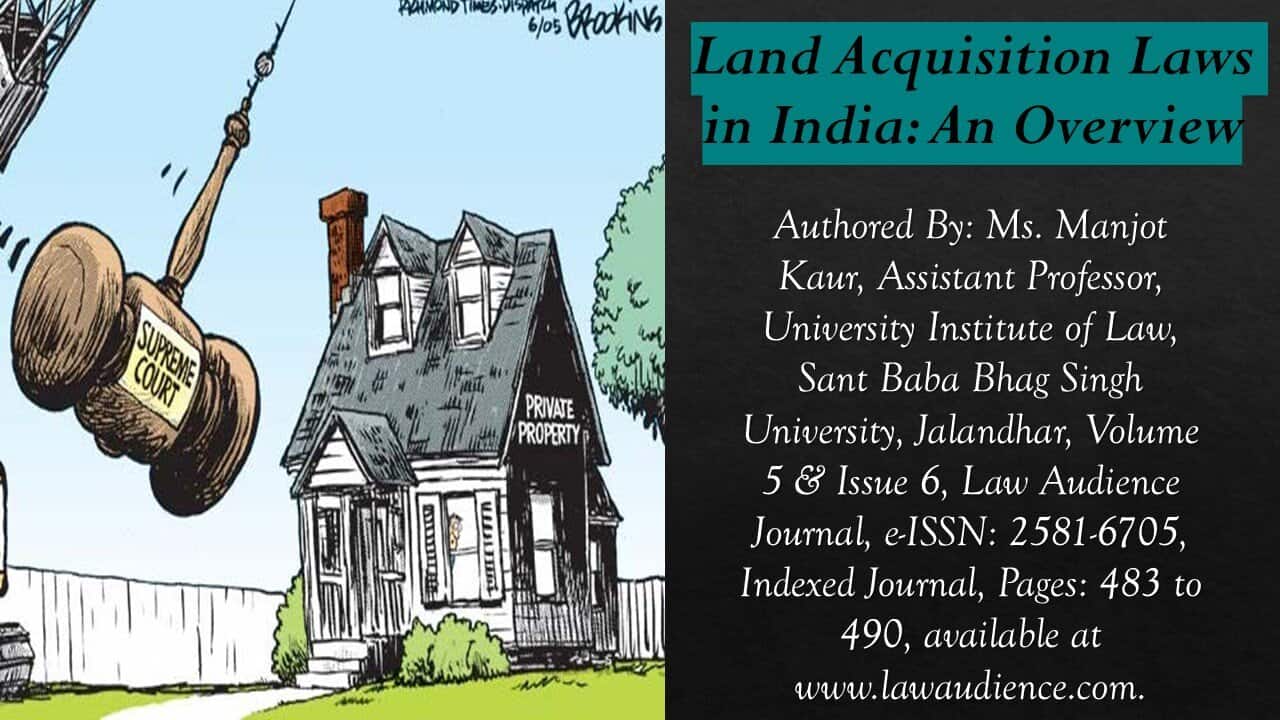Click here to download the full paper (PDF)
Authored By: Ms. Manjot Kaur, Assistant Professor, University Institute of Law, Sant Baba Bhag Singh University, Jalandhar,
Click here for Copyright Policy.
ABSTRACT:
“Land is one of the crucial resources for the survival of humans. Every person has equal and inherent right to live over this land but their acquisition and ownership over the land may vary. Since the former age, the piece of land which does not have any ownership automatically becomes the property of the government. Under the legislation for land, the government can also acquire the land from private individuals for the public purpose which has been the dynamic law and procedure since the British era in India. However, earlier the acquisition of land by the government was arbitrary, unjustifiable, and unreasonable. All the prior land-related legislation existed till the current laws were weak and abortive. Those Acts also do not deal with the concerns relating to resettlement, rehabilitation, and transparency rights of the affected parties whose land was acquired by the government on account of public purpose. Legal rights such as the Right to fair Compensation, Right to Transparency, right to rehabilitation, and Right to Resettlement concerned with the land acquisition laws were incorporated in the new legislation called “The Right to Fair Compensation and Transparency in Land Acquisition, Rehabilitation and Resettlement Act, 2013”. This paper is a critical study of the legal rights concerned with the current legislation whether they are protected or not. And to scrutinize whether the main object of the legislation to utilize the land for public purpose and to promote public welfare is implemented or not. Another objective of the paper is to determine the lacunas of the current legislation and to provide possible recommendations for the better implementation of the laws”.
I. INTRODUCTION:
The land is a basic source of livelihood for humans and the right to live in the land is inherent and attached to the land. With the development of human civilization, people who used to live, work, and cultivate on the piece of land started owning the land as a property or asset. The Doctrine of Eminent Domain was popular at that time and the government or the kings were used to follow this doctrine. Under this principle, the government authority including Britishers used to acquire property from private individuals for the public purpose to promote the public welfare. Many Acts were passed since the British era. However, the acquisition of land by the government was arbitrary, unjustifiable, and unreasonable. Also, the Acts failed to achieve their objective of public welfare and to provide fair and reasonable compensation to the affected parties. Later, new legislation was passed to provide legal rights like the right to resettlement, rehabilitation, and fair compensation.
II. HISTORY LAND ACQUISITION REFORMS BEFORE INDEPENDENCE:
The origin of the idea of land acquisition can be traced to the ancient times of monarchy when only the kings were considered as the owners of the land property and other persons was only permitted to hold any land property. However, the ownership of land property is a very dynamic concept that has changed and developed over time. Later, the rights of the individuals were also recognized but these rights were restricted after the advent of Britishers in India. During the British era, the British government started acquiring land based on Eminent Domain emerged after the Battle of Palassy and permanent settlement in India. As per the principle of Eminent Domain, the main objective is to acquire land for the public purpose instead of compensation however, this doctrine was misused by the British government. They used to acquire land for their profit although the acquisitions were non-transparent and unjustified. The payment as compensation to the affected parties after the acquisition was unfair and unreasonable. To provide the legality and legal procedure to the process of acquisition the first regulation for land acquisition was made by the British government in the year 1824 with the objective of the public welfare however they only facilitate their work for their profit and benefit. Later there were different regulations created over a long period. In 1857 (rebellion as described by the British authority) tried to lead to the abolishment of the land acquisition regulations of Britishers and this incident is also considered as the first freedom struggle in India. In 1870, another regulation was formed to overcome the flaws but failed to do so then, again in the year 1894 new laws for land acquisition were passed to improve regulations and procedures of the acquisition. The main objective of the New Act of 1894 was to establish an effective structure for the regulation and to acquire the land for public purposes. However, in the Act of 1894 there were certain defects like the term ‘public purpose’ was ambiguous, the compensation given to the parties was unfair and there was no opportunity provided to object, for the affected parties.
III. LAND ACQUISITION REFORMS AFTER INDEPENDENCE:
The provisions of the Indian Constitution. After this, the matter of land acquisition was covered under the state jurisdiction provided in the 7th schedule and authorized to make laws under the provision of Article 246 of the constitution of India. In the beginning, the land acquisition was done by the government of India based on a welfare project but later on, for some reasons, the Act of 1894 was continued by the government to acquire the land. In the constitution, the ‘right to property’ was recognized under Article 19 (1)(f), and Article 31. However, the laws related to land acquisition conflicted with property right hence, this right was acting as a hindrance in the land acquisition process by the government. The I.C. Golaknath vs. State of Punjab, case of 1967 was indeed a landmark judgment that had far-reaching consequences. In this case, the Punjab Security of Land Tenure Act 1953 was challenged on the grounds of its land ceiling provisions. The Supreme Court held that Part III of the Constitution, which deals with fundamental rights, cannot be abridged or curtailed by the Parliament through a constitutional amendment. This judgment triggered a series of constitutional amendments and led to several other judgments that sought to clarify the scope and limits of the amending power of the Parliament.
IV. LEGAL RIGHTS CONCERNED WITH LAND ACQUISITION:
There are certain rights attached to the acquisition of land which were never taken into consideration till the new Act was passed. The undermined rights were:
1. The payment of compensation given by the British government was unfair and unreasonable, however, it is the right of the affected party to get the proportional payment.
2. The objective of public purpose was ambiguous and non-transparent. It is the right of the affected party to know the utilization of the land acquired from them by the government.
3. The procedure for the rehabilitation and resettlement after the land acquisition was not considered in the previous Acts.
In the first Narmada Bachao Andolan Case, the opposition to the prior regulation was made when the Sardar Sarovar Dam’s height was increased leading to the displacement of people living nearby. The affected people were promised by the government compensation however there were no provisions for the resettlement and rehabilitation of the displaced people. After this, the protest was started in 1985 and continued till 1990. Later the government made policies for the resettlement and rehabilitation of the displaced people.
In the second Narmada Bachao Andolan case, the Supreme Court held that it is important to ensure that the rights of displaced persons are protected and that they are properly rehabilitated and resettled to lead a decent life so that there would not be the violation of fundamental rights of Article 21.
After all these incidents were taken into consideration, the new land acquisition law was enacted called “The Right to Fair Compensation and Transparency in Land Acquisition, Rehabilitation and Resettlement Act, 2013.” Under this Act, all the aspects were taken into consideration like,
1. Absence of Rehabilitation and Resettlement for displacement of affected people
2. Social Impact assessment
3. To ensure fair and reasonable compensation to the affected people
4. Lack of dispute redressal mechanism
5. Consideration of required public purpose
V. FUNDAMENTAL RIGHT TO LEGAL RIGHTS: TRANSITION OF ‘RIGHT TO PROPERTY’:
Right to Property, a fundamental right which stated” No person shall be deprived of his life, liberty or property without due process”. Hence, the right to Property as a fundamental right was recognized and enshrined under the provision of Article 19(1)(f) and Article 31 in the Indian Constitution because earlier the land acquisition process was arbitrary where the government authority used to acquire the Land of any private individual for the public purpose. However, this Right to property as a fundamental right was removed by the 44th Amendment and added as a constitutional right or legal right under the provision of Article 300 A of the Constitution. Indeed, one of the main reasons for the removal of the right to property from the fundamental rights was the large number of litigations in courts related to land acquisition by the government. These litigations were seen as an impediment to the development process, which included infrastructure development and agriculture reforms. The “Right to Property” conflicted with the Land Acquisition Act as there was a contradictory nature between the capitalist right and the socialist right. Meanwhile, the Golaknath v. State Of Punjab, or simply the Golaknath case, was a 1967 Indian Supreme Court case, in which the Court ruled that Parliament could not curtail any of the Fundamental Rights in the Constitution. But after the 44th Amendment, the ‘Right to Property’ is dead as a fundamental right but considered as a legal right or a constitutional right. This can be observed in the case of Jilubhai Nanbhai Khachar vs. State of Gujrat; it was held that the Right to Property U/A 300A is not a basic structure of the Constitution. It is only a constitutional right. Currently, the ‘Right to Property’ is protected as a constitutional right under the Indian Constitution provided in the provision of Article 300 (A) which states that “No person shall be deprived of his property save by the authority of law”.
VI. EFFICIENCY OF “THE RIGHT TO FAIR COMPENSATION AND TRANSPARENCY IN LAND ACQUISITION, REHABILITATION AND RESETTLEMENT ACT, 2013.”:
The bill of the Act was passed in 2011; however, it was passed in 2013 and came into force on 1st January 2014. There are certain amendments made in the year 2015. The main aim of the act of LARR, 2013 is to ensure fair and reasonable compensation to the affected parties whose land property has been acquired by the government authority, to ensure transparency in the process of land acquisition, and to facilitate the resettlement and rehabilitation to the displaced parties in the procedure of land acquisition. Other objectives of the New Act are to overcome the inequalities between the state and the land losers and to achieve the requirement of consent and Social Impact Assessment.
VII. LACUNAS IN “THE RIGHT TO FAIR COMPENSATION AND TRANSPARENCY IN LAND ACQUISITION, REHABILITATION AND RESETTLEMENT ACT, 2013.”:
VII.I INEFFICIENT LAND REFORMS:
Although the legal reforms are essential this is insufficient for ensuring efficiency and equality within the process of land acquisition.
VII.II INCLUSIVENESS OF THE TERM ‘PUBLIC PURPOSE’:
The definition of ‘public purpose’ is not precisely defined in the Land Acquisition Act or the Constitution of India. In the case of M/S. Royal Orchid Hotels Ltd, it was held that the land acquired by the state for public purpose cannot be transferred to private entities for private use, as this would amount to a diversification of public purpose. The concept of public purpose cannot be expanded to legitimize fraudulent activity. The judiciary carefully examines whether the public purpose is being diverted for private use, even after the acquisition process has been completed.
VIII. CONCLUSION:
‘Right to Property’ are contradictory concepts, and why the ‘Right to Property’ was struck down as a fundamental right. The issue of resettlement and compensation has been a heated topic since the colonial era, and the constitution sought to address this by providing guarantees through Article 19(f) and Article 31. The removal of the Right to Property as a fundamental right has had a great impact on the history of land acquisition law in India. Although it is said that public necessity is greater than private necessity hence, this should be implemented reasonably and justifiably. Considering the Right to freedom as a fundamental right then it is proportional to independence which is directly correlated with the Right to Property. Hence it could also be pertained as a basic structure. , The LARR Act was enacted in 2013 to overcome the flaws in the previous laws. The New Act is successful in achieving some of the requirements like fair compensation rehabilitation and resettlement but it still lagging in providing equality between the state and land losers and determining the exclusive definition of the term public purpose. The current Act can become effective by the proper implementation of the procedure, by examining the state activity of land acquisition, and by scrutinizing the credibility and legitimacy of the term ‘Public Purpose’. The misuse of the Act on account of Public Purpose has been witnessed in certain cases hence, the power and the role of government to decide the public purpose should be analyzed and declined, and the role of justice provider protagonist i.e., the Judiciary, to protect and promote the interest of individual whose land is acquired should be augmented.
Cite this article as:
MS. MANJOT KAUR, “Land Acquisition Laws in India: An Overview” Vol.5 & Issue 6, Law Audience Journal (e-ISSN: 2581-6705), Pages 483 to 490 (15th May 2025), available at https://www.lawaudience.com/land-acquisition-laws-in-india-an-overview/.
References:
Statutes:
• Constitution of India, 1950
• The Right to Fair Compensation and Transparency in Land Acquisition, Rehabilitation and Resettlement Act, 2013
Books:
• Dr. Anukriti Mishra, Land Laws
• Kanwal D P Singh, Land Laws (Including Land Acquisition and Rent Laws) 2nd Edition
Articles/Journals/ Websites:
•https://en.wikipedia.org/wiki/I.C._Golaknath_and_Ors._vs_State_of_Punjab_and_Anrs.#:~:text=Golaknath%20v.,Fundamental%20Rights%20in%20the%20Constitution.&text=I.C.,-Golaknath%20and%20Ors (23 March 2025)
• Right to Property and its Evolution in India, https://www.legalserviceindia.com/legal/article-3774-right-to-property-and-its-evolution-in-india.html,
• Right to Property, Article, Amendment, SC Judgements https://www.studyiq.com/articles/right-to-property/ (April 4, 2025)
Cases:
• N.D. Jayal v. Union of India, (2004) 9 SCC 362
• Narmada Bachao Andolan Case
• Golaknath v. State of Punjab, (1967 AIR 1643, 1967 SCR (2) 762)
• Jilubhai Nanbhai Khachar v. State of Gujrat, AIR 1995 SC 142
• Hari Krishna Mandir Trust vs the State of Maharashtra and Others, Civil Appeal No. 6156 of 2013
• M/S. Royal Orchid Hotels Ltd & Anr vs G. Jayarama Reddy & Ors, 2011 AIR SCW 6081



